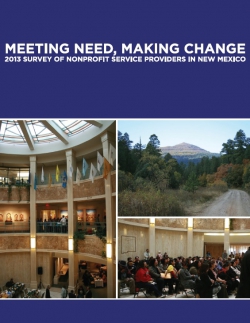Meeting Need, Making Change: 2013 Survey of Nonprofit Service Providers in New Mexico
New Mexico is a state rich with resources – both natural and human – and a history of community engagement and collaboration to support the common good. The state’s traditions are reflected in the diversity of the over 2,000 nonprofit organizations that work in communities to help people face challenges and overcome obstacles.
This survey is a small snapshot of one segment of those nonprofits – service providers – and how they are faring in obtaining public funding and engaging in advocacy. With the growing numbers of New Mexicans who have been struggling in the wake of the 2008 to 2009 recession, the survey was a first attempt to see if groups were receiving less (or more) public funding and more (or less) demand for their services.
In their book, Forces for Good: The Six Practices of High Impact Nonprofits, Leslie Crutchfield and Heather McLeod Grant found that successful nonprofits work with and through other organizations and individuals to create more impact than they can alone. Inspired by the potential for nonprofits to have greater impact collectively, the Building Movement Project conducted this survey to also look at how nonprofit groups are working together in coalitions both to advance their work and advocate for policy change. In the last quarter of 2013, nonprofit service organizations in New Mexico completed a short, confidential, online survey. Individuals in leadership positions at organizations providing direct health and/or human and social services to individuals and/or families were encouraged to share their views and opinions.
The data on hardship in New Mexico reflect national trends across the country. Non-profit organizations are responding to increasing demand for services and reductions in the funding needed to address the struggles of clients, their families, and communi-ties. New Mexico has also faced its share of funding cuts to programs and services needed by individuals and families. For instance, in the 2011 fiscal year, the state cut cash assistance payments for low-income disabled residents by one-third. Cuts in K-12 education spending led to reductions of 11.4% in per-student spending between fiscal years 2008 and 2014.
In the midst of the many challenges to organizational health and barriers to the self-sufficiency of community members, countless nonprofit organizations across the state play an important role in providing services to help people maintain a measure of security and human dignity. These survey findings indicate how groups are working to ultimately overcome their circumstances through personal and social change

